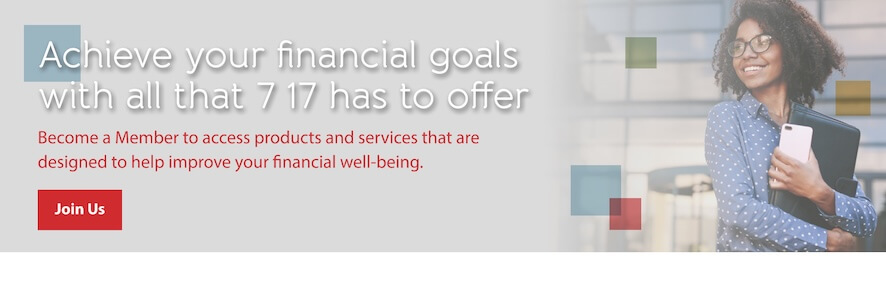- 7 17 Staff
Practical Tips for Boosting Your Financial Wellness

We tend to think of physical or mental health when focusing on well-being. But your financial wellness is just as important to focus on. In many cases, struggling with financial instability or debt can impact your mental health.
When you’re in control of your finances, you’ll find you have more confidence in your decisions and purchasing power. Here are some financial wellness tips to help you get more in control and feel a sense of security.
How To Understand Your Current Financial Situation and Goals
Financial wellness means you understand your financial situation and are able to manage it effectively. It’s not just about how much money you’re earning—it’s also about how you’re managing your finances. It means not being stressed about money because you have a clear understanding of how to manage your financial situation.
How can you understand your current financial situation and your future goals?
Understanding your earnings, your spending, your debts and your savings is critical to understanding your financial situation. To develop a clear picture of your situation, it can help to make a list of all of your debts, income and expenses to help determine your budget. Tracking your expenses through a money management or mobile banking app can also be a good idea.
By tracking your income, expenses and savings, you’ll also have an idea of how close you are to meeting your financial goals, such as saving for a house or retirement.
Tips To Improve Your Financial Wellness
Financial matters can be stressful and overwhelming at times. Here’s how you can get clarity on your financial situation now and in the long run so you can make more informed decisions.
Reevaluate Your Budget
Your budget isn’t a one-and-done process. It’s going to constantly evolve over time as you pay off debts and take on new financial responsibilities, such as if you’ve purchased a new car or house. Grocery costs also change over time, which is why it’s important to reevaluate your budget a few times a year so you can optimize how much you’re spending and saving.
Be Conscious of Your Spending
Impulse purchases have a way of getting out of hand. Whether it’s lunches out, trips to a coffee shop or frequent clothing purchases, it can all add up quickly. A budget can help you determine how much extra funds you can set aside for these types of purchases, and a money management or mobile banking app can help you track how much is being spent on impulse purchases.
Start an Emergency Fund
An emergency fund is a savings account set aside for unforeseen expenses, such as job loss, medical expenses or car repairs. Having an emergency fund can help sustain you through these tough situations without going into debt by reaching for a credit card.
An emergency fund should have approximately 3–6 months’ worth of expenses in it, but you may need more than that to ensure you feel financially secure in an emergency. To set aside money in your emergency fund, simply choose your frequency—whether on paydays, weekly or monthly—and set up automatic transfers so you don’t have to worry about remembering to withdraw money.
Keep Track of Your Credit Reports
Make it a goal to periodically check your credit reports. This will help you keep track of your goals, see how paying off debts is helping your credit and catch anything that seems like fraudulent activity.
Reduce Your Debt
Carrying a lot of debt from month to month can feel overwhelming. One of the biggest steps you can take toward financial wellness and stability is to reduce your debt through practices such as debt consolidation or paying down balances through a debt snowball or avalanche method.
Debt consolidation involves paying off as much debt as you can through a personal loan, or by transferring balances from other credit cards over to a new balance transfer credit card. This practice consolidates several payments each month into one payment to spend less money over time.
The debt snowball method involves paying off your smallest balance by putting as much money as you can toward the balance, and then moving on to the next smallest balance. The debt avalanche method involves paying off your highest interest balance first, and once that debt is eliminated, addressing the next highest balance until your debts are gone.
Explore Financial Wellness Tips, Products and More
Your credit union or bank can do a lot to help boost your financial wellness through valuable resources, financial products and more. Explore 7 17 Credit Union’s selection of savings, checking, money market accounts, certificates and more by opening an account today.
